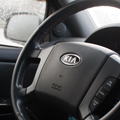
Загорается "ESP OFF"
-

Алексей 45 - Сообщения: 7472
- Зарегистрирован: 07 мар 2011, 12:59
- Откуда: Курган
- Благодарил (а): 134 раз.
- Поблагодарили: 74 раз.
- Имя: Алексей
- Автомобиль: Другая машина
- Год выпуска: 2007
- Доп. информация: Инфинити QX 60
Мицубиси паджеро 4 3.8 Бензин газ

Re: Загорается "ESP OFF"
Алексей 45 писал(а):что сдохло и как
с вероятностью 90 % у тебя проблема с датчиком АБС.
Какой- выяснит диагностика. Пока рано переживать. Замена - не проблема !.
другая машина
-

alexleon - Сообщения: 463
- Зарегистрирован: 18 май 2010, 21:30
- Откуда: СПБ
- Благодарил (а): 4 раз.
- Поблагодарили: 5 раз.
- Имя: Алексей
- Автомобиль: Sorento BL, 2.5TD (170 л/с), TOD, AT
- Год выпуска: 2006
- Доп. информация: черный, EX (был)

Re: Загорается "ESP OFF"
Алексей 45 писал(а):что сдохло и как
Неделю как периодически загорается "ESP OFF", соответственно перестал работать и круиз-контроль. Благо на улице уже нет снега со льдом, ЕСП особо не нужен.
Соренто Классик: на 180 отрывает отрывало "дворники" от лобового 
Соренто Р: пока ничего не отрывает

Соренто Р: пока ничего не отрывает

-

Que - Сообщения: 961
- Зарегистрирован: 18 авг 2009, 11:22
- Откуда: Санкт-Петербург
- Благодарил (а): 66 раз.
- Поблагодарили: 22 раз.
- Имя: Илья
- Автомобиль: Sorento XM, 2.2TD (197 л/с), 4WD, AT, 7 мест
- Год выпуска: 2010
- Доп. информация: Кореец. Чип-тюнинг, No-EGR, No-DPF, Пружины Kayaba R3474 + Клаксон. Koni FSD. Распорка Полигон.

Re: Загорается "ESP OFF"
вот результат????
кто что думает

Добавлено через 9 минут 57 секунд:
ошибки
с1627
с1203
с1205
с2402
с1702
?????
если только дело в датчике абс то
кто что думает


Добавлено через 9 минут 57 секунд:
ошибки
с1627
с1203
с1205
с2402
с1702
?????

если только дело в датчике абс то

-

Алексей 45 - Сообщения: 7472
- Зарегистрирован: 07 мар 2011, 12:59
- Откуда: Курган
- Благодарил (а): 134 раз.
- Поблагодарили: 74 раз.
- Имя: Алексей
- Автомобиль: Другая машина
- Год выпуска: 2007
- Доп. информация: Инфинити QX 60
Мицубиси паджеро 4 3.8 Бензин газ

Re: Загорается "ESP OFF"
Без перевода. Сухая расшифровка кодов. Суровая копипаста из офф. мануала.
C1627
The HECU interchanges requirement data with the 4WD ECU through CAN bus line for normal ABS control. For example the HECU sends a control inhibition signal to 4WD ECU for normal ABS control in case of the ABS and 4WD control requested at the same time such as wheel speed difference between front and rear wheel generated due to wheel slip.
C1203
The wheel speed sensor is the essential component the ABS ECU uses to calculate vehicle speed and to determine whether wheel lock occurs. For example, rear wheel speed signal is used as a referecnce value, for vehicle speed, in front wheel drive vehicles, and if a difference between front and rear wheel speed occurs, then ABS control is performed. Wheel speed sensor is active hall-sensor type and good at temperature and noise chariteristic. Digital waveform is produced as tone wheel rotate according as hall sensor principle. Frequency of duty waveform is changed in proportion to rotation of tone wheel and HECU calculate vehicle speed by this frequency.
C1205
The wheel speed sensor is the essential component the ABS ECU uses to calculate vehicle speed and to determine whether wheel lock occurs. For example, rear wheel speed signal is used as a referecnce value, for vehicle speed, in front wheel drive vehicles, and if a difference between front and rear wheel speed occurs, then ABS control is performed. Wheel speed sensor is active hall-sensor type and good at temperature and noise chariteristic. Digital waveform is produced as tone wheel rotate according as hall sensor principle. Frequency of duty waveform is changed in proportion to rotation of tone wheel and HECU calculate vehicle speed by this frequency.
C2402
The HECU supplies battery power to the electric motor with a motor relay which is controlled by the Electronic Control Unit(ECU). The electric motor pump supplies hydraulic pressure to all wheel brake calipers by operating the piston inside the pump.
C1702
There is no hardware difference of the HECU according to the vehicle's specification, just software is changed by the vehicle parameter used for ESP control. The HECU stores a classified variant code value according to the received data(a kind of engine, engine displacement, a kind of T/M). After then the HECU read a various parameter according to the stored variant value in the memory to use for the ESP control.
C1627
The HECU interchanges requirement data with the 4WD ECU through CAN bus line for normal ABS control. For example the HECU sends a control inhibition signal to 4WD ECU for normal ABS control in case of the ABS and 4WD control requested at the same time such as wheel speed difference between front and rear wheel generated due to wheel slip.
C1203
The wheel speed sensor is the essential component the ABS ECU uses to calculate vehicle speed and to determine whether wheel lock occurs. For example, rear wheel speed signal is used as a referecnce value, for vehicle speed, in front wheel drive vehicles, and if a difference between front and rear wheel speed occurs, then ABS control is performed. Wheel speed sensor is active hall-sensor type and good at temperature and noise chariteristic. Digital waveform is produced as tone wheel rotate according as hall sensor principle. Frequency of duty waveform is changed in proportion to rotation of tone wheel and HECU calculate vehicle speed by this frequency.
C1205
The wheel speed sensor is the essential component the ABS ECU uses to calculate vehicle speed and to determine whether wheel lock occurs. For example, rear wheel speed signal is used as a referecnce value, for vehicle speed, in front wheel drive vehicles, and if a difference between front and rear wheel speed occurs, then ABS control is performed. Wheel speed sensor is active hall-sensor type and good at temperature and noise chariteristic. Digital waveform is produced as tone wheel rotate according as hall sensor principle. Frequency of duty waveform is changed in proportion to rotation of tone wheel and HECU calculate vehicle speed by this frequency.
C2402
The HECU supplies battery power to the electric motor with a motor relay which is controlled by the Electronic Control Unit(ECU). The electric motor pump supplies hydraulic pressure to all wheel brake calipers by operating the piston inside the pump.
C1702
There is no hardware difference of the HECU according to the vehicle's specification, just software is changed by the vehicle parameter used for ESP control. The HECU stores a classified variant code value according to the received data(a kind of engine, engine displacement, a kind of T/M). After then the HECU read a various parameter according to the stored variant value in the memory to use for the ESP control.
Последний раз редактировалось Que 25 апр 2012, 14:53, всего редактировалось 4 раз(а).
Соренто Классик: на 180 отрывает отрывало "дворники" от лобового 
Соренто Р: пока ничего не отрывает

Соренто Р: пока ничего не отрывает

-

Que - Сообщения: 961
- Зарегистрирован: 18 авг 2009, 11:22
- Откуда: Санкт-Петербург
- Благодарил (а): 66 раз.
- Поблагодарили: 22 раз.
- Имя: Илья
- Автомобиль: Sorento XM, 2.2TD (197 л/с), 4WD, AT, 7 мест
- Год выпуска: 2010
- Доп. информация: Кореец. Чип-тюнинг, No-EGR, No-DPF, Пружины Kayaba R3474 + Клаксон. Koni FSD. Распорка Полигон.

Re: Загорается "ESP OFF"
Мне кажется что где обрыв/кз в проводах/коннекторах.
Соренто Классик: на 180 отрывает отрывало "дворники" от лобового 
Соренто Р: пока ничего не отрывает

Соренто Р: пока ничего не отрывает

-

Que - Сообщения: 961
- Зарегистрирован: 18 авг 2009, 11:22
- Откуда: Санкт-Петербург
- Благодарил (а): 66 раз.
- Поблагодарили: 22 раз.
- Имя: Илья
- Автомобиль: Sorento XM, 2.2TD (197 л/с), 4WD, AT, 7 мест
- Год выпуска: 2010
- Доп. информация: Кореец. Чип-тюнинг, No-EGR, No-DPF, Пружины Kayaba R3474 + Клаксон. Koni FSD. Распорка Полигон.

Re: Загорается "ESP OFF"
Алексей 45 писал(а):кто что думает
посмотрю свою распечатку, когда провод переднего левого датчика АБС оторвали.
Кстати поменял его в выходные - дело 20 минут. Не то, что с задним возиться. Здесь даже локер снимать не пришлось. Только АКБ вытащить, ну и колесо конечно.
другая машина
-

alexleon - Сообщения: 463
- Зарегистрирован: 18 май 2010, 21:30
- Откуда: СПБ
- Благодарил (а): 4 раз.
- Поблагодарили: 5 раз.
- Имя: Алексей
- Автомобиль: Sorento BL, 2.5TD (170 л/с), TOD, AT
- Год выпуска: 2006
- Доп. информация: черный, EX (был)

Re: Загорается "ESP OFF"
снял то я его без проблем пришел новый не тот 
звоняца одинаково
а в ступице ничего сдохнуть не может???
Добавлено через 7 часов 24 минуты 32 секунды:
и где находиться блок управления абс

звоняца одинаково

а в ступице ничего сдохнуть не может???
Добавлено через 7 часов 24 минуты 32 секунды:
и где находиться блок управления абс

-

Алексей 45 - Сообщения: 7472
- Зарегистрирован: 07 мар 2011, 12:59
- Откуда: Курган
- Благодарил (а): 134 раз.
- Поблагодарили: 74 раз.
- Имя: Алексей
- Автомобиль: Другая машина
- Год выпуска: 2007
- Доп. информация: Инфинити QX 60
Мицубиси паджеро 4 3.8 Бензин газ

Re: Загорается "ESP OFF"
имнип, там же где и блок абс
Соренто Классик: на 180 отрывает отрывало "дворники" от лобового 
Соренто Р: пока ничего не отрывает

Соренто Р: пока ничего не отрывает

-

Que - Сообщения: 961
- Зарегистрирован: 18 авг 2009, 11:22
- Откуда: Санкт-Петербург
- Благодарил (а): 66 раз.
- Поблагодарили: 22 раз.
- Имя: Илья
- Автомобиль: Sorento XM, 2.2TD (197 л/с), 4WD, AT, 7 мест
- Год выпуска: 2010
- Доп. информация: Кореец. Чип-тюнинг, No-EGR, No-DPF, Пружины Kayaba R3474 + Клаксон. Koni FSD. Распорка Полигон.

Re: Загорается "ESP OFF"
Алексей 45 писал(а):где находиться блок управления абс
Вот здесь Тема: Загорается "ESP OFF".
Разъем как раз от него.
Ниже на Photo14 показан сам блок.
alexleon писал(а):посмотрю свою распечатку, когда провод переднего левого датчика АБС оторвали.
Вот ошибка при обрыве левого переднего датчика АБС - С1200.
Лечится заменой датчика.
-----------
Так же высветилась ошибка С1209 - обрыв правого заднего датчика, хотя датчик был заменен год назад.
Ошибка отсоединением АКБ не стирается.
Скинули ее только сканером.
Третья ошибка С1627 - ошибка 4WD CAN сигнала или ошибка связи . В системе ABS.
Сказали, что это связано с датчиками. Осталась она или нет - не знаю.
другая машина
-

alexleon - Сообщения: 463
- Зарегистрирован: 18 май 2010, 21:30
- Откуда: СПБ
- Благодарил (а): 4 раз.
- Поблагодарили: 5 раз.
- Имя: Алексей
- Автомобиль: Sorento BL, 2.5TD (170 л/с), TOD, AT
- Год выпуска: 2006
- Доп. информация: черный, EX (был)

Re: Загорается "ESP OFF"
а что у меня то сдохло??? 
Добавлено через 2 дня 8 часов 37 минут 51 секунду:
всё поменял датчик АБС и



Добавлено через 2 дня 8 часов 37 минут 51 секунду:
всё поменял датчик АБС и



-

Алексей 45 - Сообщения: 7472
- Зарегистрирован: 07 мар 2011, 12:59
- Откуда: Курган
- Благодарил (а): 134 раз.
- Поблагодарили: 74 раз.
- Имя: Алексей
- Автомобиль: Другая машина
- Год выпуска: 2007
- Доп. информация: Инфинити QX 60
Мицубиси паджеро 4 3.8 Бензин газ

Re: Загорается "ESP OFF"
Алексей 45 писал(а):всё поменял датчик АБС
Ну вот, не так страшен АБС, как его малюют.
другая машина
-

alexleon - Сообщения: 463
- Зарегистрирован: 18 май 2010, 21:30
- Откуда: СПБ
- Благодарил (а): 4 раз.
- Поблагодарили: 5 раз.
- Имя: Алексей
- Автомобиль: Sorento BL, 2.5TD (170 л/с), TOD, AT
- Год выпуска: 2006
- Доп. информация: черный, EX (был)

Re: Загорается "ESP OFF"
Алексей 45 писал(а):всё поменял датчик АБС и
ну вот и чудненько =)
Соренто Классик: на 180 отрывает отрывало "дворники" от лобового 
Соренто Р: пока ничего не отрывает

Соренто Р: пока ничего не отрывает

-

Que - Сообщения: 961
- Зарегистрирован: 18 авг 2009, 11:22
- Откуда: Санкт-Петербург
- Благодарил (а): 66 раз.
- Поблагодарили: 22 раз.
- Имя: Илья
- Автомобиль: Sorento XM, 2.2TD (197 л/с), 4WD, AT, 7 мест
- Год выпуска: 2010
- Доп. информация: Кореец. Чип-тюнинг, No-EGR, No-DPF, Пружины Kayaba R3474 + Клаксон. Koni FSD. Распорка Полигон.

Re: Загорается "ESP OFF"
Всем доброго времени суток.
В воскресенье был на сканере и вылезла ошибка 1702, 1627, 1234. Мастер сказал что главная проблема в ошибке 1702 (по его словам: неправильная, устаревшая прошивка блока ABS/ESP), после ее решения говорит уже надо будет дальше копать.
Кто встречался с таким? Что посоветуете?
В воскресенье был на сканере и вылезла ошибка 1702, 1627, 1234. Мастер сказал что главная проблема в ошибке 1702 (по его словам: неправильная, устаревшая прошивка блока ABS/ESP), после ее решения говорит уже надо будет дальше копать.
Кто встречался с таким? Что посоветуете?
- krestspb
- Сообщения: 41
- Зарегистрирован: 29 мар 2011, 21:38
- Откуда: Москва-Питер
- Благодарил (а): 0 раз.
- Поблагодарили: 4 раз.
- Имя: Илья
- Автомобиль: Sorento XM, 2.4 (174 л/с), 4WD, AT
- Год выпуска: 2012
- Доп. информация: Был: Sorento BL 170 л/с TOD 2007

Re: Загорается "ESP OFF"
krestspb писал(а):неправильная, устаревшая прошивка блока ABS/ESP), после ее решения
А какого решения? Сменить прошивку, или полностью блок?
-

runner_Perm - Сообщения: 3425
- Зарегистрирован: 20 янв 2009, 14:47
- Откуда: Пермь
- Благодарил (а): 76 раз.
- Поблагодарили: 91 раз.
- Имя: Стас
- Автомобиль: Sorento BL, 2.5TD (170 л/с), TOD, AT
- Год выпуска: 2006
- Доп. информация: Люк, Бинар 5Д-С, пружины H&R, ручное управление TOD

Вернуться в Электрика и электроника (BL)
Кто сейчас на конференции
Сейчас этот форум просматривают: нет зарегистрированных пользователей и гости: 1



